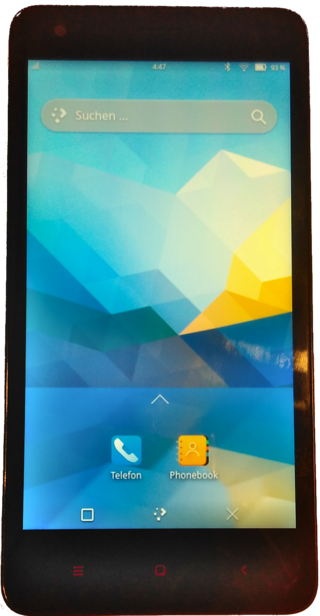
The Samsung Wave is a smartphone developed and produced by Samsung Electronics. It is the first smartphone to run the Bada operating system developed by Samsung Electronics, which was commercially released on May 24, 2010. The Wave is a touchscreen phone powered by Samsung's "Hummingbird" CPU (S5PC110), which includes 1 GHz ARM Cortex-A8 CPU and a built-in PowerVR SGX 540 graphics engine. It also has a "Super AMOLED" screen and 720p high-definition video capture capabilities. Due to shortage of Super AMOLED screens, Samsung released a successor to the device called Wave II and ceased production of the original S8500 model.

The Samsung Galaxy S is a touchscreen-enabled, slate-format Android smartphone designed, developed, and marketed by Samsung Electronics; it is the first smartphone of the Samsung Galaxy S series. It is the first device of the third Android smartphone series produced by Samsung. It was announced to the press in March 2010 and released for sale in June 2010. Due to shortage of Super AMOLED displays, Samsung released a successor to the device called S scLCD or SL and ceased production of the original I9000 model.

The ZTE Blade V880 is a smartphone manufactured by ZTE Corporation for the Android platform. Unveiled by Orange UK as San Francisco, it went on sale on 21 September 2010, with a white variant released later. By 2011, more than 8 million Blade handsets had been sold in more than 50 countries worldwide.
The Samsung Galaxy R (Royal) (GT-I9103) is an Android smartphone that was announced by Samsung on August 10, 2011 as a variant to the Samsung Galaxy S II.

The Samsung Galaxy Note is an Android smartphone produced by Samsung Electronics. Unveiled at IFA Berlin 2011, it was first released in Germany in late October 2011, with other countries following afterwards. The Galaxy Note was distinguished by its unusually large form factor—later referred to using the term "phablet"—which straddled the size of the average smartphone at the time, and that of a small tablet: it features a 5.3-inch display, and is bundled with a stylus branded as the "S Pen", which can be used to navigate the device's user interface, and write or draw in supported apps.

The Samsung Captivate Glide (SGH-i927) as it is called in the United States, and sold as the Samsung Galaxy S Glide (SGH-i927R) in Canada, is the first physical QWERTY Galaxy S class smartphone running under the Android operating system to be released by Samsung for AT&T (US) and Rogers Wireless (Canada).

The Samsung Galaxy Grand is a smartphone developed by Samsung Electronics, first announced on December 18, 2012. The phone has a dual core Cortex-A9 1.2 GHz processor and a RAM of 1 GB, with an internal memory of 8 GB which can be extended to another 64 GB by use of microSD cards. The device also supports internet connectivity through 2G and 3G, apart from Wi-Fi. Navigation systems including A-GPS and GLONASS with Google Maps. The phone runs on the Android 4.1.2 Jelly Bean OS, with Samsung releasing updates up to 4.2.2. However, custom ROMs are available up to Android 7.1.2 Nougat.

The Samsung Galaxy Note 3 is an Android phablet smartphone produced by Samsung Electronics as part of the Samsung Galaxy Note series. The Galaxy Note 3 was unveiled on September 4, 2013, with its worldwide release beginning later in the month. Serving as a successor to the Galaxy Note II, the Note 3 was designed to have a lighter, more upscale design than previous iterations of the Galaxy Note series, and to expand upon the stylus and multitasking-oriented functionality in its software—which includes a new pie menu opened through the button on the stylus for quick access to pen-enabled apps, along with pop-up apps and expanded multi-window functionality. It additionally features new sensors, a USB 3.0 port, 3 GB of RAM, and its video camera has been upgraded to 2160p (4K) resolution and doubled framerate of 60 at 1080p, placing it among the earliest smartphones to be equipped with any of these.

The Samsung Galaxy S5 is an Android-based smartphone unveiled, produced, released and marketed by Samsung Electronics as part of the Samsung Galaxy S series. Unveiled on 24 February 2014 at Mobile World Congress in Barcelona, Spain, it was released on 11 April 2014 in 150 countries as the immediate successor to the Galaxy S4. As with the S4, the S5 is an evolution of the prior year's model, placing a particular emphasis on an improved build with a textured rear cover and IP67 certification for dust and water resistance, a more refined user experience, new security features such as a fingerprint reader and private mode, expanded health-related features including a built-in heart rate monitor, a USB 3.0 port, and an updated camera featuring speedy auto-focus through phase-detection. The video resolution has been upgraded to 2160p (4K) and the frame rate at 1080p has been doubled to 60 for a smooth appearance.

AOKP, short for Android Open Kang Project, is an open-source replacement distribution for smartphones and tablet computers based on the Android mobile operating system. The name is a play on the word kang and AOSP. The name was a joke, but it stuck. It was started as free and open-source software by Roman Birg based on the official releases of Android Open Source Project by Google, with added original and third-party code, features, and control.

OmniROM is an open-source operating system for smartphones and tablet computers, based on the Android mobile platform. It involves a number of prominent developers from other projects.
The Samsung Galaxy Grand 2 is a smartphone developed by Samsung Electronics, first announced on November 25, 2013 with Google Play. The phone has a quad core 1.2 GHz processor and 1.5 GB of RAM, with an internal memory of 8 GB which can be extended to another 64 GB by use of microSD cards. The device also supports internet connectivity through 2G and 3G apart from Wi-Fi. The Google Play Newsstand, Games, Music, Movies & TV, and Books, Navigation systems including A-GPS and GLONASS with Google Maps. The phone launched with Android 4.3 OS. On 14 July 2014 the phone was upgraded to Android 4.4.2 KitKat by an OTA update. There were many issues related with the update. Many users were complaining about unexpected restarts, frequent freezing, System UI errors, unable to change lock screen wallpapers and more. All these issues have been resolved recently with the latest K1 build, which comes along with Samsung Knox.

The Samsung Galaxy A7 (2015) is an Android smartphone manufactured by Samsung Electronics and released in February 2015. The phone was not released in the United States.

Xiaomi Redmi 2 is a smartphone produced by Xiaomi released in January 2015. It is the successor to the Xiaomi Redmi 1 family.

The Samsung Galaxy J5 is an Android smartphone produced by Samsung Electronics. It was unveiled and released in June 2015. It has Qualcomm Snapdragon 410 SoC that is backed by 1.5 GB RAM and that has a 64 bit processor, 32bit mode OS.

The Xiaomi Redmi Note 3 is a smartphone developed by Xiaomi Inc. as part of Xiaomi's low-end Redmi smartphone line. It has three variants:
Samsung Galaxy Star 2 Plus G350E is a smartphone manufactured by Samsung Electronics that runs on the open source Android operating system. Announced by Samsung in early August 2014. It has additional software features, expanded hardware, and a redesigned physique from its predecessor, the Samsung Galaxy Star 2.

The Samsung Galaxy J2 Prime is an Android-based smartphone manufactured by Samsung Electronics. It was unveiled and released in November 2016.
crDroid is a customized fork of Android based on LineageOS. It is one of the first to offer unofficial releases of Android 10, Android 11, Android 12.1 and Android 13 Custom ROMs.

Bootloader unlocking is the process of disabling the bootloader security that makes secure boot possible. It can make advanced customizations possible, such as installing a custom firmware. On smartphones this can be a custom Android distribution or another mobile operating system. Some bootloaders are not locked at all, others can be unlocked using a standard command, others need assistance from the manufacturer. Some do not include an unlocking method and can only be unlocked through a software exploit.
















